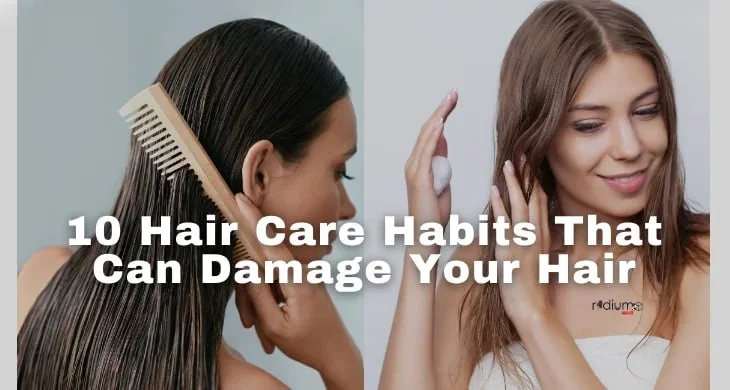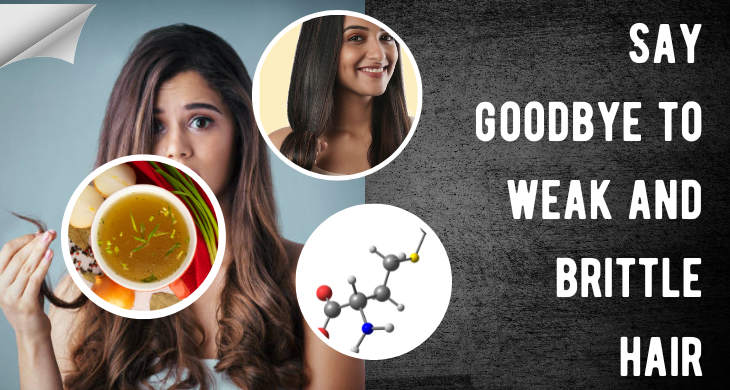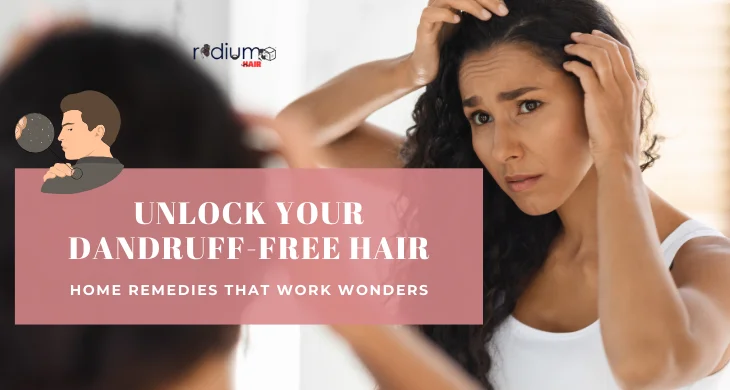As we strive for gorgeous hair, we often don’t realize that some of our habits may actually harm our locks. Damaged hair not only appears dull and lifeless but also becomes fragile and prone to breakage and thinning. However, the good news is that by making small adjustments to our hair care routine, we can prevent additional damage and encourage healthier hair growth. It’s essential to be mindful of how we treat our hair, from how we wash and style it to the products we use. By adopting healthier hair care habits, we can nurture our hair back to its natural radiance and vitality.
Washing Your Hair
- Rubbing shampoo vigorously into the length of your hair might seem like the right way to ensure it’s clean, but it can actually do more harm than good. This aggressive rubbing can tangle and weaken the strands, leading to breakage and split ends over time. Instead, opt for a gentler approach by massaging the shampoo into your scalp with your fingertips. Focus on the roots where oil and dirt accumulate, allowing the lather to naturally flow down the length of your hair as you rinse. This technique cleanses the scalp effectively while minimizing stress on the hair shaft. Remember, gentle handling is key to maintaining the health and strength of your hair, so treat it with care from root to tip.
- Gently massaging shampoo into your scalp is a simple yet crucial step in your hair care routine. By using your fingertips to massage the shampoo into your scalp, you ensure that it effectively cleanses away dirt, oil, and product buildup without causing unnecessary damage to your hair. This gentle massage stimulates blood flow to the scalp, promoting hair growth and overall scalp health. It also helps to distribute the shampoo evenly, ensuring that every part of your scalp receives the cleansing benefits. Additionally, massaging the scalp can provide a relaxing and rejuvenating experience, reducing stress and tension. Remember to take your time and be gentle with your movements, avoiding any harsh rubbing or scrubbing that could potentially damage your hair follicles. By incorporating this gentle massage into your shampooing routine, you can maintain a clean, healthy scalp and beautiful, vibrant hair.
- Rinsing shampoo without rubbing it into your hair is a simple yet effective technique to prevent damage and maintain hair health. When you skip the rubbing step and focus on rinsing thoroughly instead, you allow the shampoo to cleanse your hair without causing unnecessary friction and tangles. This gentle rinsing ensures that all traces of shampoo are washed away, leaving your hair clean and refreshed. Additionally, avoiding vigorous rubbing can help prevent breakage and minimize stress on your hair strands. Instead, gently massage your scalp with your fingertips while rinsing to ensure that any remaining shampoo residue is removed. By adopting this gentle rinsing technique, you can promote healthier hair and reduce the risk of damage and breakage, allowing your locks to look and feel their best.
Skipping the Conditioner
- Using conditioner after every shampoo is essential for maintaining healthy and beautiful hair. Conditioner helps to restore moisture, nourish the hair shaft, and smooth the cuticle, resulting in softer, more manageable hair. It also helps to detangle hair, making it easier to comb through and reducing breakage. Additionally, conditioner can provide added protection against environmental damage, such as UV rays and pollution, which can cause dryness and damage to the hair. By replenishing moisture and nutrients lost during shampooing, conditioner helps to keep the hair hydrated, vibrant, and less prone to damage. Incorporating conditioner into your hair care routine after every shampoo can significantly improve the overall health and appearance of your hair, leaving it looking shiny, silky, and healthy.
- Proper conditioning is crucial for preventing hair damage and maintaining healthy locks. To ensure effective conditioning, start by selecting a conditioner suited to your hair type and concerns, whether it’s for hydration, repair, or volume. When applying conditioner, focus on the mid-lengths and ends of your hair, where it’s most prone to dryness and damage, and avoid the scalp to prevent weighing it down. Gently massage the conditioner into your hair and leave it on for the recommended time to allow it to penetrate and nourish the strands. For deeper conditioning, consider using a hair mask or leaving the conditioner on for longer before rinsing thoroughly with lukewarm water. Additionally, use a wide-tooth comb to detangle hair while the conditioner is still in to minimize breakage. Finally, pat your hair dry with a soft towel and avoid rubbing to prevent further damage. With these tips, you can effectively condition your hair to keep it healthy, shiny, and resilient.
Swimming
- Using a swim cap is an effective way to protect your hair from the harsh chemicals found in pool water. These chemicals, such as chlorine, can strip the hair of its natural oils, leaving it dry, brittle, and prone to damage. By wearing a swim cap before entering the pool, you create a barrier between your hair and the water, minimizing its exposure to these chemicals. This helps to maintain the moisture levels in your hair and prevents it from becoming dehydrated and weakened. Additionally, a swim cap can also help to keep your hair in place and prevent it from tangling while swimming. Investing in a high-quality swim cap that fits securely and comfortably is essential for optimal protection. With a swim cap, you can enjoy your time in the pool without worrying about the damaging effects of pool chemicals on your hair.
- Rinsing your hair immediately after swimming is crucial for removing any residual pool water and chemicals that may have accumulated. Pool water contains chlorine and other chemicals that can cling to your hair, causing dryness, brittleness, and discoloration over time. By rinsing your hair promptly after swimming, you wash away these harmful substances, preventing them from lingering and causing damage. Additionally, rinsing helps to restore the natural pH balance of your hair and scalp, reducing the risk of irritation and inflammation. It’s important to use fresh water for rinsing, ideally from a shower or hose, to ensure thorough cleansing. By making rinsing a part of your post-swimming routine, you can protect your hair from the damaging effects of pool chemicals and keep it looking and feeling healthy.
- Using specialized swimmers’ shampoo and conditioner is essential for effectively removing chlorine and other chemicals from your hair after swimming. These products are specifically formulated to counteract the damaging effects of pool water, such as dryness and discoloration, while also nourishing and hydrating your hair. Swimmers’ shampoo typically contains ingredients that break down and neutralize chlorine, ensuring thorough cleansing without stripping your hair of its natural oils. Additionally, swimmers’ conditioner helps to replenish moisture and restore softness and manageability to your hair, preventing it from becoming brittle and prone to breakage. When used together, these specialized products provide comprehensive care for swimmers’ hair, leaving it clean, healthy, and vibrant. Incorporating swimmers’ shampoo and conditioner into your post-swimming routine is a simple yet effective way to protect your hair from the adverse effects of pool chemicals and maintain its overall health and appearance.
Drying Your Hair
- Avoiding rubbing hair with a towel is crucial for preventing damage and breakage. When you vigorously rub your hair with a towel, especially when it’s wet, it can cause friction and lead to hair breakage and frizz. Instead, gently pat your hair with a towel to absorb excess moisture without causing unnecessary stress on the hair shaft. Additionally, consider using a microfiber towel or an old t-shirt, as these materials are softer and gentler on the hair compared to traditional towels. Another alternative is to air dry your hair whenever possible, allowing it to dry naturally without any manipulation. By avoiding rubbing your hair with a towel, you can help maintain its strength, elasticity, and overall health, resulting in smoother, shinier, and more manageable hair.
- Opting for air-drying instead of using heat is a great way to protect your hair from damage. Heat styling tools like blow dryers, flat irons, and curling irons can cause dryness, breakage, and split ends due to the high temperatures they generate. Air-drying allows your hair to dry naturally without exposing it to excessive heat, reducing the risk of damage. Additionally, air-drying can help retain moisture in your hair, keeping it hydrated and less prone to frizz. To air-dry your hair effectively, gently squeeze out excess water with a towel and then allow your hair to dry naturally. You can speed up the drying process by blotting your hair with a microfiber towel or an old t-shirt. By choosing air-drying over heat styling, you can promote healthier hair and minimize the risk of heat-related damage.
Brushing Wet Hair
- Detangling straight hair can be a breeze with the right techniques and tools. Start by applying a leave-in conditioner or detangling spray to soften your hair and make it easier to comb through. Use a wide-tooth comb or a detangling brush to gently work through any knots or tangles, starting from the ends of your hair and gradually working your way up to the roots. Divide your hair into sections to make the process more manageable, and hold each section firmly as you detangle to minimize pulling and breakage. Take your time and be patient, especially if your hair is prone to tangling. Avoid brushing your hair when it’s wet, as it’s more vulnerable to damage when it’s saturated with water. Once you’ve detangled your hair, style it as desired, and enjoy your smooth, knot-free locks!
- Combing textured or curly hair while damp requires a gentle touch and the right approach to prevent damage and breakage. Start by applying a leave-in conditioner or detangling spray to add moisture and make your hair more manageable. Use a wide-tooth comb or your fingers to gently work through any knots or tangles, starting from the ends of your hair and working your way up to the roots. Divide your hair into sections to make the process easier, and hold each section firmly as you comb through to minimize pulling and breakage. Avoid using a brush, as it can cause frizz and damage to curly hair. Once you’ve detangled your hair, you can style it as desired or let it air dry for natural, bouncy curls. With the right techniques and products, you can keep your textured or curly hair looking healthy and beautiful.
Heat Styling
- Minimizing heat exposure by air-drying is a simple yet effective way to protect your hair from damage and maintain its natural moisture. After washing your hair, gently squeeze out excess water with a towel, being careful not to rub or twist your hair, which can cause breakage. Then, allow your hair to air dry naturally without using a hairdryer or heat styling tools. To speed up the drying process, you can gently pat your hair with a towel or use a soft cotton t-shirt to absorb excess moisture. Additionally, consider applying a leave-in conditioner or styling product to help define your natural texture and keep your hair looking smooth and shiny. By air-drying your hair instead of using heat, you can reduce the risk of heat damage and keep your locks healthy and beautiful.
- Using lower heat settings and limiting the frequency of styling tools are essential practices to protect your hair from heat damage. When using heat styling tools such as hairdryers, flat irons, or curling irons, opt for lower heat settings to minimize the risk of overheating your hair. High temperatures can weaken the hair shaft and lead to breakage and dryness. Additionally, try to limit the frequency of using heat styling tools to give your hair a break and allow it to recover from any damage. Consider embracing natural hairstyles or alternative styling methods that don’t require heat, such as air-drying, braiding, or using heatless curling techniques. By being mindful of the heat settings and frequency of styling tools, you can help maintain the health and vitality of your hair for the long term.
Styling Products
- Choosing hairstyles that don’t rely heavily on styling products can help prevent buildup and potential damage to your hair. Instead of opting for styles that require excessive amounts of gel, mousse, or hairspray, consider simpler hairstyles that showcase your natural hair texture. Embracing your hair’s natural beauty can reduce the need for heavy styling products and minimize the risk of product buildup, which can weigh down your hair and make it appear dull and lifeless. Additionally, choosing low-maintenance hairstyles can save you time and effort in your daily hair care routine. Look for styles that allow your hair to move freely and retain its natural volume and bounce without the need for excessive product application. By opting for hairstyles that prioritize simplicity and natural beauty, you can keep your hair healthy and vibrant without compromising on style.
Tight Hairstyles
- Avoiding tight hairstyles that cause tension on the hairline is crucial for maintaining healthy hair. Tight hairstyles, such as tight ponytails, braids, or buns, can exert excessive pressure on the hair follicles, leading to hair breakage and traction alopecia. By opting for looser hairstyles that allow your hair to move freely without pulling on the scalp, you can prevent damage and promote healthy hair growth. Additionally, avoiding tight hairstyles can help reduce scalp discomfort and headaches associated with tension on the hairline. Instead of tight styles, consider wearing your hair down or opting for loose, gentle braids or twists. If you prefer to wear your hair up, use soft, fabric-covered hair ties or scrunchies to minimize tension on the hairline. Prioritizing gentle hairstyles can help protect your hairline and ensure that your hair remains strong, healthy, and resilient.
- Using hair-friendly accessories and opting for looser styles are essential practices to maintain the health and integrity of your hair. Hair-friendly accessories such as silk scrunchies or fabric-covered hair ties minimize friction and prevent hair breakage compared to traditional elastic bands. Opting for looser styles, such as loose braids, ponytails, or buns, reduces tension on the scalp and hair follicles, preventing damage and promoting healthy hair growth. Additionally, incorporating accessories like hair clips or headbands can add flair to your hairstyle while protecting your hair from excessive pulling or tugging. By prioritizing hair-friendly accessories and looser styles, you can minimize the risk of hair damage and ensure that your hair remains strong, vibrant, and beautiful.
Weaves and Hair Extensions
- Selecting lightweight weaves/extensions is a smart strategy to minimize pulling and stress on your natural hair. Heavy extensions can exert excessive tension on the scalp and hair follicles, leading to discomfort and potential damage. Lightweight weaves/extensions, on the other hand, offer a more comfortable and manageable option while still achieving desired length and volume. Look for extensions made from high-quality, lightweight materials such as human hair or synthetic fibers that mimic the natural texture of your hair. These lighter options are gentler on your scalp and hair, reducing the risk of breakage and promoting healthier growth. By choosing lightweight weaves/extensions, you can enjoy the benefits of longer, fuller hair without sacrificing the health and integrity of your natural locks.
- Ensuring proper installation and maintenance of hair extensions is essential for maintaining scalp health. Proper installation involves carefully braiding the natural hair and securing the extensions without causing excessive tension or pulling. Regular maintenance, such as gentle washing and detangling, helps prevent matting and tangling, reducing strain on the scalp. It’s important to schedule regular touch-ups with a professional stylist to ensure that the extensions are securely attached and to address any potential issues promptly. Additionally, avoiding excessive heat styling and chemical treatments can help preserve the integrity of both the natural hair and the extensions. By prioritizing proper installation and maintenance practices, individuals can enjoy the benefits of hair extensions while minimizing the risk of scalp irritation or damage.
Chemical Treatments
- Extending the time between hair treatments and opting for only one service at a time can help minimize stress on the scalp and reduce the risk of damage to the hair. By spacing out treatments, such as coloring, relaxing, or perming, individuals give their hair time to recover and regain strength between chemical processes. Additionally, focusing on one service at a time allows for better control and monitoring of the hair’s condition, ensuring that it remains healthy and resilient. This approach also reduces the likelihood of over-processing or excessive damage due to multiple chemical treatments. By prioritizing the health and integrity of the hair, individuals can achieve their desired look while minimizing the risk of scalp irritation or long-term damage.
- Protecting hair from sun damage is crucial to maintaining its health and appearance. Exposure to UV rays can lead to dryness, brittleness, and color fading, so it’s essential to use products with UV protection or wear a hat when spending time outdoors. Additionally, nourishing the hair with conditioner helps to replenish moisture and nutrients lost due to sun exposure. Choose a conditioner specifically formulated for sun-damaged hair, and apply it regularly to keep your locks hydrated and resilient. Conditioning treatments can also help repair any existing damage and prevent further deterioration, leaving your hair soft, smooth, and shiny. Incorporating these protective measures into your hair care routine will help safeguard your strands from the harmful effects of the sun, ensuring they stay healthy and beautiful all year round.
Conclusion
By adopting small changes in our hair care routines, we can shield our hair from harm and enhance its overall health and strength. It’s crucial to focus on treating our hair gently, providing it with the nourishment it needs, and safeguarding it from external stressors. Prioritizing these aspects ensures that our hair remains vibrant, resilient, and beautiful. Remember to use gentle shampoos, condition regularly, and protect your hair from heat styling and environmental damage. By following these simple guidelines, you can maintain healthy, luscious locks that radiate vitality and shine. So, whether you’re washing, conditioning, or styling, always be mindful of the care your hair deserves, and you’ll reap the rewards of gorgeous, thriving hair every day.
FAQs
Que: What are some signs of hair damage?
Ans: Signs of hair damage include split ends, breakage, dryness, dullness, and excessive shedding.
Que: How often should I condition my hair?
Ans: It’s recommended to condition your hair every time you shampoo, so typically, every 2-3 days.
Que: Can swimming in chlorinated water damage hair?
Ans: Swimming in chlorinated water can indeed damage hair by stripping its natural oils and causing dryness and brittleness.
Que: Is it safe to use heat styling tools?
Ans: Heat styling tools can be safe to use if used properly with heat protectant products and at lower temperatures.
Que: How do I choose the right hairstyle to prevent hair damage?
Ans: Choosing hairstyles that minimize tension and manipulation, such as loose braids or buns, can help prevent hair damage.



